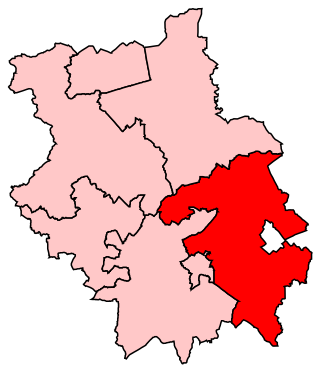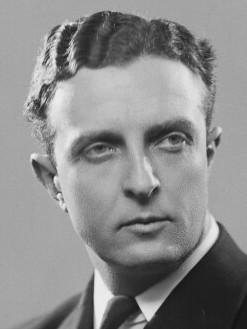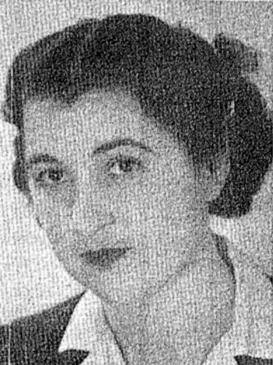| |||||||||||||||||||
Constituency of Bury St Edmunds | |||||||||||||||||||
|---|---|---|---|---|---|---|---|---|---|---|---|---|---|---|---|---|---|---|---|
| Turnout | 50.8% | ||||||||||||||||||
| |||||||||||||||||||
| |||||||||||||||||||
The 1944 Bury St Edmunds by-election was a parliamentary by-election for the British House of Commons constituency of Bury St Edmunds, Suffolk on 29 February 1944.
| |||||||||||||||||||
Constituency of Bury St Edmunds | |||||||||||||||||||
|---|---|---|---|---|---|---|---|---|---|---|---|---|---|---|---|---|---|---|---|
| Turnout | 50.8% | ||||||||||||||||||
| |||||||||||||||||||
| |||||||||||||||||||
The 1944 Bury St Edmunds by-election was a parliamentary by-election for the British House of Commons constituency of Bury St Edmunds, Suffolk on 29 February 1944.
The by-election was caused by the death of the sitting Conservative MP, Frank Heilgers who was killed in the Ilford rail crash on 16 January 1944. A local man, he had been MP here since holding the seat in 1931.
Bury St Edmunds had been won by the Conservatives at every election since the seat was created in 1885 and was a safe seat. So safe was it that Heilgers was returned unopposed in 1931 and 1935.
The local Conservatives selected 39-year-old Edgar Keatinge. Keatinge served in the Royal Artillery. [1] He commanded a mountain battery of the West African Frontier Force, [2] and became the first commander of the West African Artillery School. [1] When, after serious illness, he returned to Suffolk in 1943, he was again attached to the Suffolk Yeomanry, eventually reaching the rank of lieutenant-colonel. [2] He had been a member of West Suffolk County Council since 1933, and was selected in 1938 as the Conservative prospective parliamentary candidate for the Isle of Ely constituency, [1] to stand against Liberal MP James de Rothschild. The parties had expected a general election in late 1939, but it was postponed for the duration of the war.
The Bury St Edmunds Liberals had selected H.C. Drayton as prospective parliamentary candidate for the next general election. [3] At the outbreak of war, the Conservative, Liberal and Labour parties had agreed an electoral truce which meant that when a by-election occurred, the party that was defending the seat would not be opposed by an official candidate from the other two parties. When the Labour and Liberal parties joined the Coalition government, it was agreed that any by-election candidate defending a government seat would receive a letter of endorsement jointly signed by all the party leaders. This was enough to deter Bury St Edmunds Liberals from submitting their candidate.
However, the 62-year-old leading Liberal activist Margery Corbett Ashby decided to contest the seat. She resigned her position in the Liberal Party, and stood as an Independent Liberal candidate, with the support of the Radical Action group. She had been President of the International Woman Suffrage Alliance since 1923. [4] She received an honorary LLD at Mount Holyoke College, USA, in 1937 in recognition of her international work. In 1942 she went on a government propaganda mission to Sweden. [5] She had no connection with the area and it hardly seemed the most promising of seats for a Liberal to enter parliament. Ashby had a track record of flying the Liberal flag in some less hopeful constituencies that included 1918 Birmingham Ladywood, 1922 and 1923 Richmond, Surrey, 1924 Watford, 1929 Hendon and 1935 and 1937 Hemel Hempstead. [6]
Polling day was set for 29 February 1944. When nominations closed, it was to reveal a two horse race, between the Conservative Keatinge and the Independent Liberal Ashby.
Keatinge received a joint letter of endorsement from all the leaders of the parties in the coalition, including Liberal Leader, Sir Archibald Sinclair. It was also announced that H.C. Drayton, the local Liberals ppc would speak in support of Keatinge. [3]
Unlike the Independent Liberal candidates at 1943 Chippenham by-election and 1943 Darwen by-election, Ashby attracted plenty of outside help, firstly from large numbers of Liberals who were growing tired of the electoral truce. Secondly, she was able to enlist the support of Richard Acland and his successful Common Wealth Party by-election circus. Furthermore, she benefited from organised support in Bury St Edmunds that went by the name of the United Progressive Front. This group included Liberal, Labour and Communist activists, harking back to the pre-war days of the Popular Front. [7]
The contest gained national attention, and became seen as a test of the credibility of the government. [1]
The Conservative Keatinge hung onto the seat;
| Party | Candidate | Votes | % | ±% | |
|---|---|---|---|---|---|
| Conservative | Edgar Keatinge | 11,705 | 56.2 | N/A | |
| Independent Liberal | Margery Corbett Ashby | 9,121 | 43.8 | New | |
| Majority | 2,584 | 12.4 | N/A | ||
| Turnout | 20,828 | 50.8 | N/A | ||
| Conservative hold | Swing | N/A | |||
Neither Keatinge nor Ashby stood at the 1945 general election. The result at the following General Election saw the anti-Tory vote increase to the point that they would have gained the seat had the vote not been split between three candidates;
| Party | Candidate | Votes | % | ±% | |
|---|---|---|---|---|---|
| Conservative | Geoffrey Clifton-Brown | 15,013 | 48.7 | −7.5 | |
| Labour | Cecily Alicia McCall | 9,195 | 29.8 | New | |
| Liberal | H.C. Drayton | 5,863 | 19.0 | New | |
| Common Wealth | E. C. Gordon England | 750 | 2.4 | New | |
| Majority | 5,818 | 18.9 | −6.5 | ||
| Turnout | 30,821 | 67.8 | +17.0 | ||
| Conservative hold | Swing | ||||

Central Suffolk and North Ipswich is a constituency represented in the House of Commons of the UK Parliament since 2024 by Patrick Spencer of the Conservative Party.

Bury St Edmunds was a constituency in Suffolk from 1621 to 2024, most recently represented in the House of Commons of the UK Parliament from 2015 to 2024 by Jo Churchill, a Conservative.

South East Cambridgeshire was a constituency represented in the House of Commons of the UK Parliament from 2015 to 2024 by Lucy Frazer, a member of the Conservative Party who has served as the Culture Secretary since 2023. The constituency was established for the 1983 general election and was based on the cathedral city of Ely.
The 1943 Darwen by-election was a by-election held on 15 December 1943 for the British House of Commons constituency of Darwen in Lancashire.

The 1943 Chippenham by-election was a parliamentary by-election held in England on 24 August 1943 for the British House of Commons constituency of Chippenham in Wiltshire.
The 1943 Midlothian and Peebles Northern by-election was a parliamentary by-election held in Scotland on 11 February 1943 to elect a new Member of Parliament (MP) for the House of Commons constituency of Midlothian and Peebles Northern.
Major Sir Edgar Mayne Keatinge CBE JP was an English farmer, soldier and Conservative Party politician. He is best known for having served as the Member of Parliament (MP) for Bury St Edmunds from 1944 to 1945, after a high-profile by-election. He disliked the name Edgar and preferred to introduce himself as "Mike". An obituarist describes him as "a simple and loyal man who had, for a brief period, endured a significant role in national life; and discharged his duty with honour".
The 1943 St Albans by-election was a parliamentary by-election held in England in October 1943 for the House of Commons constituency of St Albans in Hertfordshire.
The 1916 Newington West by-election was a parliamentary by-election held in England on 10 January 1916 to elect a new Member of Parliament (MP) for the House of Commons constituency of Newington West in South London.
The 1939 Batley and Morley by-election was a parliamentary by-election held in the United Kingdom on 9 March 1939 for the House of Commons constituency of Batley and Morley in the West Riding of Yorkshire.

The 1939 Hythe by-election was a parliamentary by-election held on 20 July 1939 for the British House of Commons constituency of Hythe.
The 1943 Eddisbury by-election was a parliamentary by-election for the British House of Commons constituency of Eddisbury on 7 April 1943.
The 1941 Lancaster by-election was a parliamentary by-election for the British House of Commons constituency of Lancaster, Lancashire on 15 October 1941.
The 1943 Daventry by-election was a parliamentary by-election for the British House of Commons constituency of Daventry, Northamptonshire, on 20 April 1943.

Honor Catherine Mary Balfour, was a British Liberal Party politician and journalist.
The 1944 Skipton by-election was a parliamentary by-election for the British House of Commons constituency of Skipton, Yorkshire held on 7 January 1944.
Radical Action was a political group within the British Liberal Party. It advocated for Liberal candidates to stand in elections despite the war-time electoral pact.

Daisy Cooper is a British politician who has served as Member of Parliament (MP) for St Albans since 2019. She has served as Deputy Leader of the Liberal Democrats since 2020, as well as the Liberal Democrat spokesperson for Health, Wellbeing and Social Care since 2021.

Bury St Edmunds and Stowmarket is a constituency of the House of Commons in the UK Parliament represented since its creation for the 2024 general election by Peter Prinsley of the Labour Party. The constituency is named for the Suffolk towns of Bury St Edmunds and Stowmarket.